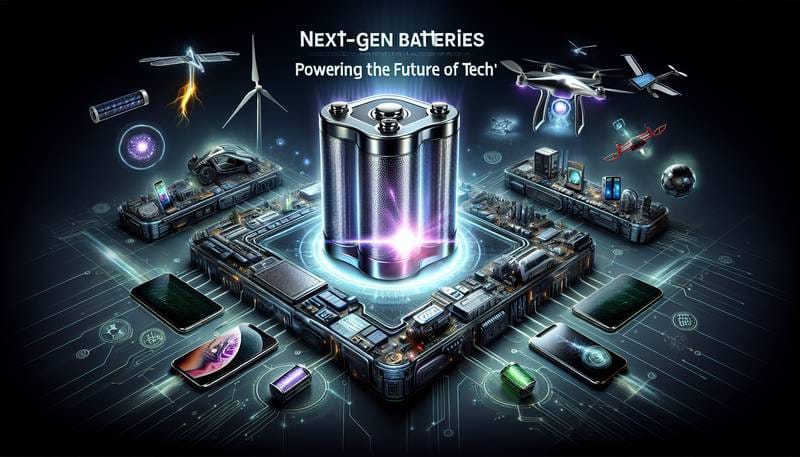Next-Gen Batteries: Powering the Future of Tech

Imagine a world where your phone never dies, your electric car takes you on a cross-country road trip without stopping to charge, and renewable energy sources are efficiently stored for use on demand. This future is not as far off as it may seem, thanks to the rapid advancements in next-generation battery technology. With the rise of electric vehicles and the increasing reliance on portable electronic devices, the demand for better, longer-lasting batteries has never been higher. In this article, we'll explore the exciting developments in next-gen batteries and how they are set to revolutionize the tech industry.
The Limitations of Current Battery Technology
Before we dive into the future of batteries, let's take a look at the current state of battery technology. The most common type of battery used today is the lithium-ion (Li-ion) battery, which powers everything from smartphones to electric cars. While Li-ion batteries have seen significant improvements over the years, they still have their limitations. They have a limited lifespan, can be prone to overheating, and their capacity diminishes over time. Moreover, the materials used in Li-ion batteries, such as cobalt and lithium, are finite resources that come with environmental and ethical concerns related to their extraction.
Next-Gen Batteries: An Overview
Enter next-gen batteries, which promise to address these issues and offer a host of improvements over current technology. Researchers and companies around the globe are working on various types of next-gen batteries, including solid-state, lithium-sulfur, and flow batteries, to name a few. These next-gen batteries aim to provide higher energy density, faster charging times, longer life cycles, improved safety, and lower environmental impact. Let's take a closer look at some of the most promising next-gen battery technologies.
Solid-State Batteries
One of the most highly-anticipated next-gen battery technologies is the solid-state battery. Unlike Li-ion batteries, which use liquid electrolytes, solid-state batteries use solid electrolytes, which can be made from ceramic, glass, or other materials. This design eliminates the risk of leaks or fires associated with liquid electrolytes and allows for higher energy density and faster charging times. Companies like Toyota and QuantumScape are at the forefront of solid-state battery development, with the potential to revolutionize the electric vehicle industry.
Lithium-Sulfur Batteries
Lithium-sulfur (Li-S) batteries offer another promising alternative to traditional Li-ion batteries. Li-S batteries have the potential to provide a higher energy density while also being lighter and cheaper to produce. The main challenge with Li-S batteries is their short lifespan, but recent advancements have shown significant improvements in this area. Companies like Oxis Energy and Sion Power are leading the charge in bringing Li-S batteries to market.
Flow Batteries
Flow batteries, also known as redox flow batteries, store energy in liquid electrolytes that flow through a cell stack. This design allows for easy scalability and the ability to store energy for long periods, making flow batteries an ideal solution for grid-scale energy storage. While flow batteries are not as compact as other next-gen batteries, their ability to provide stable and reliable energy makes them a critical component in the transition to renewable energy sources.
The Impact of Next-Gen Batteries on the Tech Industry
The impact of next-gen batteries on the tech industry cannot be overstated. As these batteries become more efficient and cost-effective, they will enable a wide range of technological advancements. Electric vehicles will become more practical for everyday use, with longer driving ranges and quicker charging times. Portable electronic devices will become even more mobile, with batteries that last longer and charge faster. Renewable energy sources like solar and wind will become more viable as efficient energy storage solutions are developed.
Aside from the direct benefits to consumers, next-gen batteries will also have a significant impact on the environment. With the increased use of electric vehicles and renewable energy, we can expect a reduction in carbon emissions and a decrease in our reliance on fossil fuels. The shift to next-gen batteries also presents an opportunity to move away from environmentally damaging mining practices for materials like cobalt and lithium.
The Challenges of Next-Gen Battery Adoption
While the future of next-gen batteries looks bright, there are still challenges to overcome before they become mainstream. High production costs, supply chain constraints, and the need for widespread infrastructure to support electric vehicles are some of the hurdles facing next-gen batteries. Additionally, the recycling and disposal of current and next-gen batteries present environmental and logistical challenges that must be addressed.
Despite these challenges, the momentum behind next-gen batteries is undeniable. Governments around the world are investing in research and development, and companies are racing to bring these technologies to market. With continued innovation and collaboration across industries, next-gen batteries have the potential to power a more sustainable and technologically advanced future.
Conclusion
As we stand on the brink of a battery revolution, it's clear that next-gen batteries are set to play a pivotal role in powering the future of tech. From solid-state to lithium-sulfur to flow batteries, these next-gen technologies promise to deliver safer, longer-lasting, and more environmentally-friendly power sources. While challenges remain, the advancements in next-gen batteries are fuelling a brighter future for the tech industry and the planet. So, get ready to say goodbye to the limitations of current battery technology and hello to a world where next-gen batteries drive innovation and sustainability.


